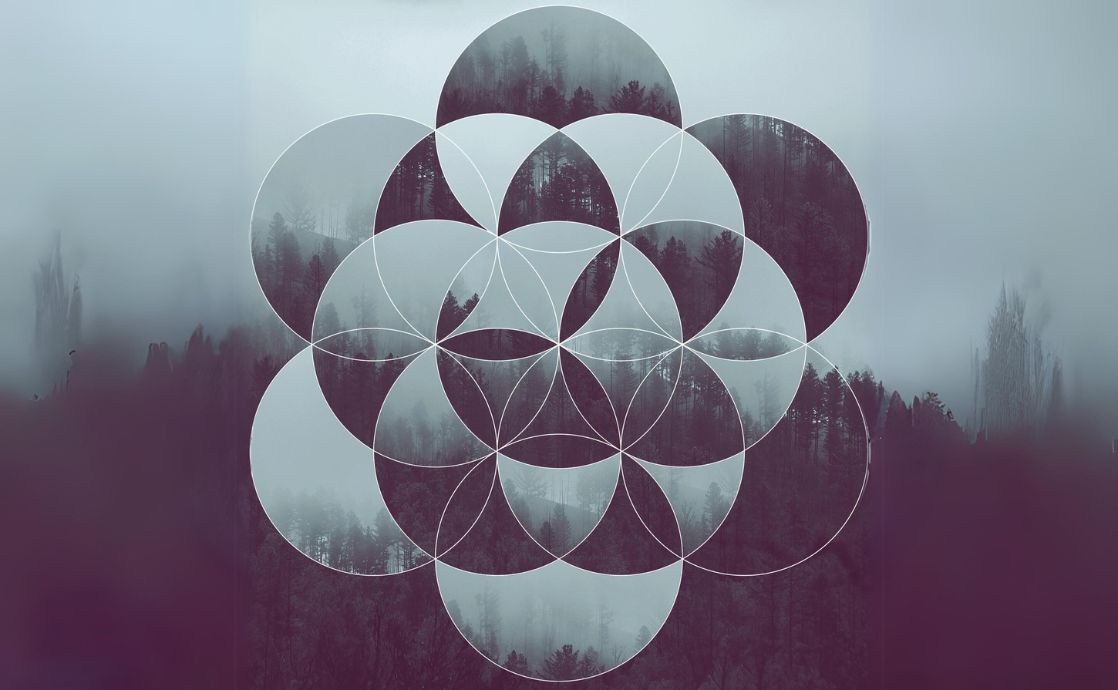The views expressed in our content reflect individual perspectives and do not represent the authoritative views of the Baha'i Faith.
I recently came across an explanation of a beautiful symbol that really intrigued me — the “Flower of Life.”
If you’ve ever heard of it, you know that the Flower of Life is a two-dimensional illustration of “sacred geometry” containing 19 equally proportioned, overlapping, and interconnected circles that create symmetrical flowers:
RELATED: Seeking Spiritual Shelter: Where Can I Be Safe?
Some say that at the heart of The Flower of Life, also expressed in related concepts such as the Tree of Life or the Seed of Life, is the belief that the Creator made the universe with a geometric plan. This proposition was reinforced by the ancient Greek philosopher Plato, who said, “The knowledge of which geometry aims is the knowledge of the eternal.”
The connection between these concepts lies in their shared themes of creation, interconnectedness, interdependence, and the underlying patterns that shape existence.
When I first learned about the Flower of Life, it made me curious to know about any potential connections to the Baha’i Faith because the number 19 is an important symbol in the Baha’i Faith — and also because the Baha’i writings often utilize trees, flowers, and seeds to allegorically represent oneness, unity, and interconnectedness. This passage from a speech Abdu’l-Baha gave in Paris in 1911 illustrates:
Behold a beautiful garden full of flowers, shrubs, and trees. Each flower has a different charm, a peculiar beauty, its own delicious perfume and beautiful color. The trees too, how varied are they in size, in growth, in foliage — and what different fruits they bear! Yet all these flowers, shrubs and trees spring from the self-same earth, the same sun shines upon them and the same clouds give them rain.
So it is with humanity. It is made up of many races, and its peoples are of different color, white, black, yellow, brown and red — but they all come from the same God, and all are servants to Him.
With respect to the number nineteen, the Bab — Baha’u’llah’s predecessor and herald, along with his first eighteen disciples, known as the Letters of the Living — made 19 a unique number. The Persian word “vahid” has a numerical value of 19 and means “unity,” symbolizing the unity of God.
The symbolic phrase “Tree of Life” also appears throughout the Baha’i writings. This profound insight from one of Abdu’l-Baha’s speeches in America in 1912 expands upon the various cycles of renewal:
Briefly, there were many universal cycles preceding this one in which we are living. They were consummated, completed and their traces obliterated. The divine and creative purpose in them was the evolution of spiritual man, just as it is in this cycle. The circle of existence is the same circle; it returns. The tree of life has ever borne the same heavenly fruit.
In the context of the Baha’i Faith, the Flower of Life does not appear to be explicitly mentioned in its teachings — but I did find several interesting connections to explore, including several general spiritual concepts. For example, many see the Flower of Life as a symbol of unity and interconnectedness. Similarly, the Baha’i Faith emphasizes the oneness of humanity and the interconnectedness of all religions. Baha’u’llah wrote:
The Prophets of God should be regarded as physicians whose task is to foster the well-being of the world and its peoples, that, through the spirit of oneness, they may heal the sickness of a divided humanity.
RELATED: The Curious Case of the Twin Mysteries: Humanity, and Our Creator
The geometric perfection of the Flower of Life reflects harmony and balance. This idea aligns with the Baha’i principle of the essential harmony of science and religion, emphasizing the importance of both in human development. Abdu’l-Baha explained that important principle:
… the religion which does not walk hand in hand with science is itself in the darkness of superstition and ignorance.
Much of the discord and disunion of the world is created by these man-made oppositions and contradictions. If religion were in harmony with science and they walked together, much of the hatred and bitterness now bringing misery to the human race would be at an end.
The Flower of Life is considered “sacred geometry” because it represents some of the fundamental shapes and forms underlying the structure of the universe. In a similar vein, the Baha’i teachings recognize the mystical and symbolic dimensions of reality that go beyond the material world. Abdu’l-Baha described that immortal reality this way:
… all phenomena of the material world are subject to mortality and death, but the immortal spirit does not belong to the phenomenal world; it is holy and sanctified above material existence.
The geometric patterns found in the Flower of Life can be seen as reflective of the order and beauty inherent in nature. The Baha’i Faith encourages the appreciation of nature as a means of connecting with the divine and recognizing the hand of the Creator in the world around us. The Baha’i teachings consider God as the Creator of all things, and the intricate design of the Flower of Life can be seen as a reflection of divine creativity and intelligence. The repetitive, cyclical nature of the Flower of Life can be interpreted as a symbol of renewal and eternal life. This idea resonates with the Baha’i belief in the eternal nature of the soul and the concept of spiritual rebirth.
All in all, I have to say that I’m happy to know about the interesting intersection between the concept of The Flower of Life and the unitary principles of the Baha’i Faith, all expressed in themes of unity, interconnectedness, perfection, spiritual development, nature and renewal, and the pursuit of divine knowledge.
















Comments
Sign in or create an account
Continue with Googleor